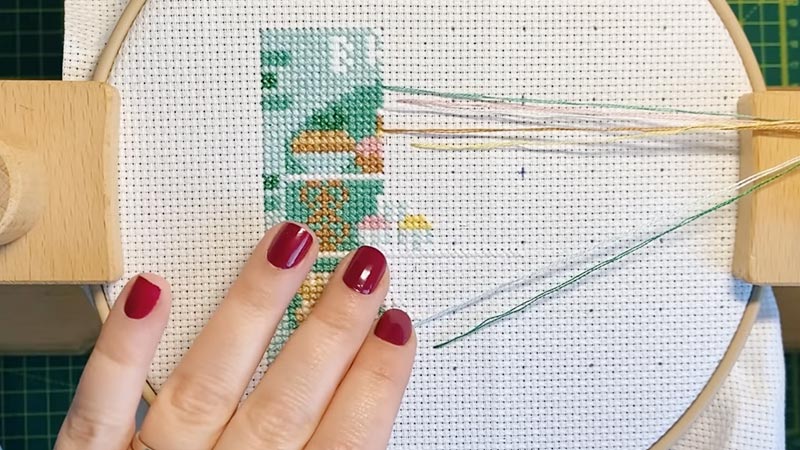Embarking on the journey of crafting and selling cross-stitch patterns unveils a world of creativity and entrepreneurship.
It’s a fusion of artistry and business acumen, where intricate designs come to life with the promise of finding a place in the homes and hearts of fellow stitching enthusiasts.
This guide is your compass, navigating through the steps required to create compelling cross-stitch patterns for sale.
From honing your stitching skills to defining a unique style, we’ll delve into the intricacies of design, digitization, packaging, and pricing. With an eye on legal and financial considerations, let’s embark on this rewarding venture together.

How to Make Cross Stitch Patterns to Sell?
Creating and selling cross-stitch patterns can be a rewarding and potentially profitable venture for those passionate about needlework and design.
You can turn your love for cross-stitch into a thriving business with the right approach.
Here’s a step-by-step guide on how to make cross-stitch patterns to sell:
Gather Your Tools
To create cross-stitch patterns, you’ll need a few essential tools, including:
- Cross-stitch design software.
- Computer or tablet.
- Color palette.
- Cross-stitch fabric.
- Needles and embroidery hoops.
Develop Your Cross-Stitch Skills
Before you can create patterns to sell, you need a strong foundation in cross-stitching.
Practice different stitches, experiment with various fabrics and threads, and learn different techniques to become proficient in the craft. The better you are at cross-stitching, the more valuable your patterns will be.
Choose Your Niche
Determine your target audience and niche within the cross-stitching market.
Consider factors such as themes (e.g., animals, landscapes, inspirational quotes), complexity (e.g., beginner, intermediate, advanced), and style (e.g., traditional, modern, whimsical). Identifying your niche will help you tailor your patterns to a specific audience.
Create Unique Designs
Allow your creativity to flourish. Explore different styles, color palettes, and motifs.
Pay attention to the small details that can make your patterns stand out, such as unique border designs or creative use of negative space. Keep a sketchbook or digital notebook handy to jot down ideas and inspirations as they come to you.
Digitize Your Designs
Familiarize yourself with your chosen design software. Learn how to create and edit patterns, select and assign thread colors, and add symbols or colors to represent each thread.
Take your time to ensure that every element of the pattern is clear and easy to understand.
Test Your Patterns
Stitch your designs using the patterns you’ve created. This step is crucial for identifying any potential issues or ambiguities in your instructions.
Pay attention to thread color choices and ensure they offer sufficient contrast. Consider enlisting the help of fellow cross-stitch enthusiasts to provide feedback on the clarity and accuracy of your patterns.
Package and Price Your Patterns
Think about how you’ll present your patterns to potential customers. Develop professional-looking packaging or PDF files for digital downloads.
When determining your pricing, factor in the time it took to create the pattern, the complexity of the design, and the cost of any software or tools you used. Be mindful of offering competitive prices within your niche.
Create a Brand and Online Presence
Establish a consistent brand identity that reflects your unique style. This includes a memorable logo, color scheme, and design elements that carry through to your website, social media profiles, and packaging.
Ensure your online presence is user-friendly, with clear navigation and high-quality images of your patterns.
Market Your Patterns
Implement a comprehensive marketing strategy. Use social media platforms like Instagram, Pinterest, and Facebook to showcase your designs.
Engage with the cross-stitching community by joining forums and groups or participating in challenges. Consider offering occasional promotions or discounts to attract new customers and reward loyal ones.
Provide Excellent Customer Service
Respond promptly to customer inquiries and feedback. Be attentive to any issues or concerns they may have and work diligently to resolve them.
Consider providing additional resources such as tutorials or stitching tips to enhance the overall customer experience.
Stay Updated and Innovate
Keep an eye on emerging trends in cross-stitching. Experiment with new techniques, color combinations, or design styles to keep your patterns fresh and appealing to a wide audience.
Regularly update your catalog with new releases to maintain customer interest and attract repeat business.
Customer Support and Feedback

Customer support and feedback are crucial components of any successful business. They are pivotal in building trust, improving products or services, and fostering customer loyalty.
Here’s a comprehensive overview of how to manage customer support and feedback effectively:
Establish Clear Channels of Communication
Provide multiple ways for customers to contact you, including email, phone, social media, and a website contact form. Ensure contact information is easily accessible on your website and social media profiles.
Train Support Staff
When you have a team handling customer support, ensure they are well-trained in your products or services. They should be knowledgeable, patient, and empathetic when dealing with customer inquiries or concerns.
Be Prompt and Responsive
Respond to customer inquiries in a timely manner. Aim to reply within 24 hours, even if it’s to acknowledge receipt of their message. Quick responses demonstrate that you value your customers’ time and concerns.
Provide Clear and Helpful Information
When assisting customers, offer clear and concise information or solutions. Avoid using jargon or technical terms that might confuse them. If necessary, provide step-by-step instructions or additional resources to address their queries.
Actively Seek Feedback
Encourage customers to share their thoughts and experiences. Consider using surveys, feedback forms, or follow-up emails after a purchase. This information can be invaluable for making improvements to your products or services.
Listen and Empathize
Actively listen to your customers and acknowledge their feelings or concerns. Show empathy and understanding, even if you can’t immediately resolve their issue. A compassionate approach can go a long way in building trust.
Resolve Issues Promptly
When a customer has a problem, take steps to address it as quickly as possible. If a resolution will take time, keep the customer informed about the progress and provide regular updates.
Learn from Negative Feedback
Don’t shy away from negative feedback. Instead, view it as an opportunity for improvement.
Analyze the feedback to identify patterns or recurring issues. Use this information to make necessary changes to your products, services, or customer support processes.
Show Appreciation
Express gratitude to customers for taking the time to provide feedback, whether it’s positive or constructive.
Let them know that their input is valuable and contributes to the ongoing improvement of your business.
Implement Changes and Updates
Act on the feedback you receive by making necessary improvements. This might involve refining your products, enhancing services, or adjusting internal processes.
Communicate these changes to your customers to demonstrate that you value their input.
Monitor Customer Satisfaction Metrics
Keep track of customer satisfaction metrics, such as Net Promoter Score (NPS) or Customer Satisfaction (CSAT) scores. These metrics can help you measure the effectiveness of your customer support efforts and identify areas for improvement.
Foster a Feedback-Oriented Culture
Encourage a culture within your business that values and welcomes customer and employee feedback. Create an environment where everyone feels comfortable sharing their thoughts and ideas for improvement.
Scaling Your Business

Scaling a business involves expanding its operations, revenue, and reach while maintaining or improving its efficiency. It’s an exciting yet challenging endeavor that requires careful planning and execution.
Here’s a step-by-step guide on how to scale your business:
Evaluate Your Current Position
Begin by assessing your business’s current strengths, weaknesses, opportunities, and threats (SWOT analysis).
Understand your financials, customer base, market share, and operational capacity. This will provide a clear baseline for your growth strategy.
Define Your Scaling Goals
Set specific, measurable, achievable, relevant, and time-bound (SMART) goals.
Determine what success looks like for your business in terms of revenue, customer acquisition, market share, and other key performance indicators (KPIs).
Invest in Technology and Systems
Implement or upgrade your technology infrastructure to support the increased demands of a larger operation. This may include upgrading software, adopting new tools for automation, and enhancing your website or e-commerce platform.
Expand Your Product or Service Offering
Consider diversifying your offerings to cater to a broader audience or to meet different needs within your existing customer base. This could involve creating new products, services, or packaging options.
Focus on Customer Acquisition and Retention
Develop a comprehensive marketing and sales strategy to attract new customers while retaining existing ones. Utilize digital marketing, social media, content marketing, and other channels to increase your brand’s visibility.
Optimize Your Operations
Streamline and improve your internal processes to handle increased demand efficiently. This may involve revising workflows, training employees, and investing in software or tools that enhance productivity.
Consider Strategic Partnerships
Collaborate with complementary businesses to tap into new markets or distribution channels. Partnerships can help you reach a wider audience and offer added value to your customers.
Hire and Train Talent
As your business expands, you’ll likely need to hire additional staff. Ensure that your hiring process is thorough and that new employees receive proper training. Focus on hiring individuals who align with your company’s values and goals.
Seek Financing
Evaluate your financial needs for scaling and consider seeking additional funding. This could come from sources like bank loans, investors, venture capital, or crowdfunding.
Manage Cash Flow and Finances
With increased operations, it’s crucial to maintain a healthy cash flow. Keep a close eye on your financials, budgeting, and cash reserves to ensure you can cover expenses and invest in growth initiatives.
Tips for Success

Success in business is a multifaceted goal involving strategy, hard work, adaptability, and effective decision-making.
Here are some valuable tips to help you achieve success in your entrepreneurial endeavors:
Set Clear and Achievable Goals
Break down your long-term goals into smaller, actionable steps. For example, if your long-term goal is to increase revenue by 20% annually, set monthly or quarterly revenue targets to track your progress.
Develop a Solid Business Plan
Your business plan should be a document for external stakeholders and a dynamic tool that guides your decision-making. Regularly review and update it to reflect changes in your business environment.
Focus on Your Unique Value Proposition
Clearly communicate your unique value proposition in your marketing materials, website, and customer interactions. Ensure that customers understand why your product or service is the best choice for them.
Understand Your Market and Customers
Conduct surveys, interviews, and market research to gain insights into customer behavior. Use this information to refine your offerings and tailor your marketing messages.
Build a Strong Brand
A strong brand is built on consistency. This includes everything from your logo and color scheme to your messaging and customer experience. A cohesive brand identity fosters trust and recognition.
Embrace Innovation
Stay curious and open to new ideas. Regularly engage with industry trends, attend conferences, and network with innovators. Look for opportunities to adopt emerging technologies or methodologies to give your business an edge.
Prioritize Customer Service
Train your team to actively listen to customer feedback and respond promptly to inquiries or issues.
Personalized interactions and a customer-centric approach can set you apart from competitors.
Manage Your Finances Wisely
Use accounting software to track income and expenses. Monitor key financial ratios like gross margin, operating margin, and return on investment to ensure your business is financially healthy.
Network and Build Relationships
Attend industry events, join professional associations, and engage on social media platforms. Building relationships with peers, mentors, and potential clients can lead to valuable collaborations and opportunities.
Learn Continuously
Stay up-to-date with industry publications, blogs, and podcasts. Consider enrolling in courses or workshops to acquire new skills or deepen your expertise in relevant areas.
Adapt to Change
Monitor market trends, customer feedback, and industry shifts. Be ready to pivot your business model or adjust your strategies to meet evolving demands.
FAQS
Can I sell cross-stitch patterns on online marketplaces?
You can sell cross-stitch patterns on platforms like Etsy, Amazon Handmade, and other similar marketplaces.
Do I need design software to create cross-stitch patterns?
You’ll need design software like PCStitch or Pattern Maker to create and edit cross-stitch patterns.
Is it important to obtain permission to use reference images in my patterns?
Yes, having the appropriate permissions to use or modify reference images is crucial to avoid copyright infringement.
Can I offer both digital and physical versions of my cross-stitch patterns for sale?
Yes, you can offer both digital downloads and physical copies of your cross-stitch patterns to cater to different customer preferences.
Do original designs tend to be more marketable than using reference images?
Yes, original designs often have a higher market appeal as they offer something unique and distinctive to customers.
To Recap
In the world of cross-stitch pattern design and sales, creativity meets entrepreneurship. Crafting and marketing your own patterns can be both fulfilling and profitable.
To succeed, start with a strong foundation of cross-stitching skills, define your niche, and invest in quality tools and design software.
Creating unique, well-organized patterns that cater to your target audience is key. Pricing, branding, and online presence are crucial in your business strategy.
Providing excellent customer support and seeking feedback ensures customer satisfaction and loyalty. As you navigate the complexities of legal and financial aspects, remember that success in this craft is a blend of passion, dedication, and adaptability.
Leave a Reply